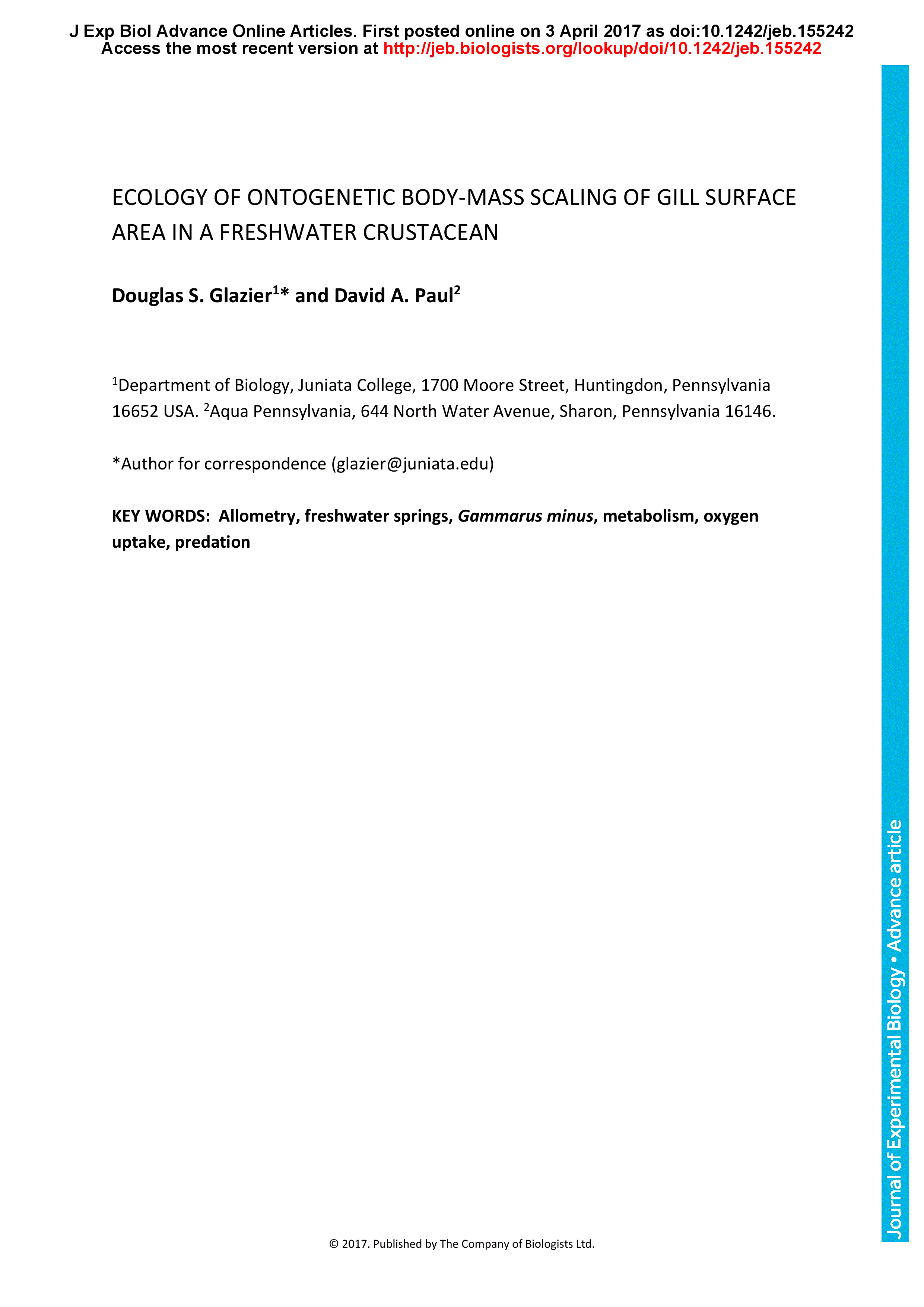Several studies have documented ecological effects on intra- and interspecific body-size scaling of metabolic rate. However, little is known about how various ecological factors may affect the scaling of respiratory structures supporting oxygen uptake for metabolism. Our study is apparently the first to provide evidence for ecological effects on the scaling of a respiratory structure among conspecific populations of any animal. We compared the body-mass scaling of gill surface area (SA) among eight spring-dwelling populations of the amphipod crustacean Gammarus minus. Although gill SA scaling was not related to water temperature, conductivity or G. minus population density, it was significantly related to predation regime (and secondarily to pH). Body-mass scaling slopes for gill SA were significantly lower in four populations inhabiting springs with fish predators than for those in four springs without fish (based on comparing means of the population slopes, or slopes calculated from pooled raw data for each comparison group). As a result, gill SA was proportionately smaller in adult amphipods from fish vs. fishless springs. This scaling difference paralleled similar differences in the scaling exponents for the rates of growth and resting metabolic rate. We hypothesized that gill SA scaling is shallower in fish vs. fishless spring populations of G. minus because of effects of size-selective predation on size-specific growth and activity that in turn affect the scaling of oxygen demand and concomitantly the gill capacity (SA) for oxygen uptake. Although influential theory claims that metabolic scaling is constrained by internal body design, our study builds on previous work to show that the scaling of both metabolism and the respiratory structures supporting it may be ecologically sensitive and evolutionarily malleable.
Ecology of ontogenetic body-mass scaling of gill surface area in a freshwater crustacean
Currently Viewing Accepted Manuscript - Newer Version Available
- Split-screen
- Views Icon Views
- Open the PDF for in another window
-
Article Versions Icon
Versions
- Version of Record 01 June 2017
- Accepted Manuscript 01 January 2017
- Share Icon Share
-
Tools Icon
Tools
- Search Site
Douglas S. Glazier, David A. Paul; Ecology of ontogenetic body-mass scaling of gill surface area in a freshwater crustacean. J Exp Biol 2017; jeb.155242. doi: https://doi.org/10.1242/jeb.155242
Download citation file:
Advertisement
2023 JEB Outstanding Paper Prize shortlist and winner

The JEB Editors are delighted to announce the shortlisted authors for the 2023 JEB Outstanding Paper Prize. Read the winning paper - Tiny spies: mosquito antennae are sensitive sensors for eavesdropping on frog calls - by Hoover Pantoja-Sanchez and Brian Leavell from Ximena Bernal's lab at Purdue University, USA.
JEB Science Communication Workshop for ECRs

If you’re an early-career researcher interested in science communication and are attending the SEB Annual Conference in Prague this summer, come a day early and join the JEB Editors at a sci comm workshop to learn the key writing skills needed to promote your research to a broad audience beyond your peers (1 July at 14.30-17.30). Places are limited to 24 attendees, and applicants should apply through the SEB registration page by 30 April 2024.
Bridging the gap between controlled conditions and natural habitats in understanding behaviour

Novel technologies enable behavioural experiments with non-model species, in naturalistic habitats and with underexplored behaviours. In their Commentary, Scholz and colleagues discuss how to obtain a deeper understanding of the natural ecology and lifestyle of study animals.
How a macrourid fish remains buoyant at depths it should be unable to reach

Fish with swimbladders should not be capable of descending below 7200m, but when Alan Jamieson and Todd Bond spotted a macrourid fish at 7259m, they knew they had seen something miraculous. Working with Imantes Priede, they reveal that the swimbladder of a 1 kg fish could hold 37.9 g of oxygen, sufficient to offset the weight of the fish's bones, and take 221-440 days to fill, which is plausible because it takes years for the fish to descend to such depths.
ECR Workshop on Positive Peer Review

Are you an ECR looking for tips on how to write concise, astute and useful manuscript reviews? If so, join the JEB Editors at a 2-hour JEB-sponsored Workshop on Positive Peer Review at the Canadian Society of Zoologists annual meeting in Moncton on 9 May 2024 at 13.00-15.00. There are 25 spaces for ECRs and selection is first come, first serve. To sign up, check the ECR Workshop box when you register for the CSZ meeting.



